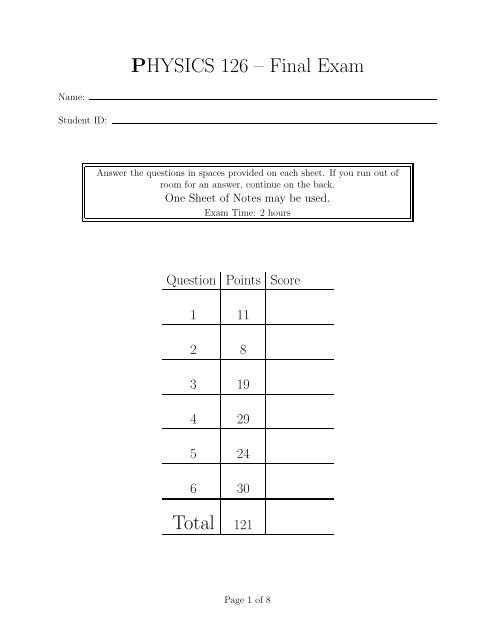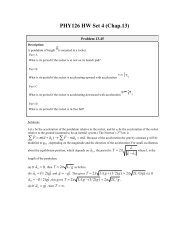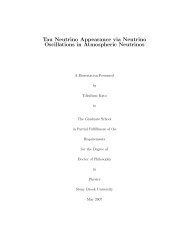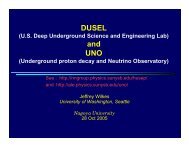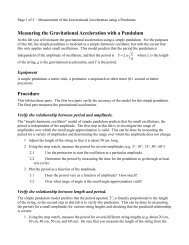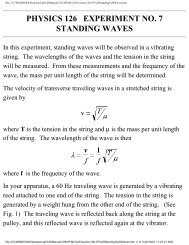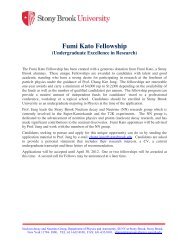You also want an ePaper? Increase the reach of your titles
YUMPU automatically turns print PDFs into web optimized ePapers that Google loves.
<strong>PHYSICS</strong> <strong>126</strong> – <strong>Final</strong> <strong>Exam</strong><br />
Name:<br />
Student ID:<br />
Answer the questions in spaces provided on each sheet. If you run out of<br />
room for an answer, continue on the back.<br />
One Sheet of Notes may be used.<br />
<strong>Exam</strong> Time: 2 hours<br />
Question Points Score<br />
1 11<br />
2 8<br />
3 19<br />
4 29<br />
5 24<br />
6 30<br />
<strong>Total</strong> <strong>121</strong><br />
Page 1 of 8
1. An object is placed 6 cm from a lens with a focal length of 3 cm.<br />
3 (a) Ray trace the object to find the location of the image. Label your diagram with<br />
the object distance and the image distance.<br />
F<br />
F<br />
3 (b) Is the image real or virtual? Explain.<br />
5 (c) Using the lens equation, find the image distance.<br />
Page 2 of 8
2. An object is placed 2 cm from a mirror with a focal length of 4 cm.<br />
3 (a) Ray trace the object to find the location of the image. Label your diagram with<br />
the object distance and the image distance.<br />
C<br />
F<br />
5 (b) Using the mirror equation, find the image distance.<br />
Page 3 of 8
3. A 1 cm radius pipe connects a 3 m tall water tower to a faucet.<br />
7 (a) What is the gauge pressure at the faucet when the faucet is closed?<br />
12 (b) What is the gauge pressure at the faucet if the faucet is opened so that there is a<br />
flow of 0.2 l/s? Assume that the water flow is laminar.<br />
Page 4 of 8
4. A violin has four strings that are 32 cm long and are typically tuned to concert G, D,<br />
A, and E (196 Hz, 294 Hz, 440 Hz, and 660 Hz).<br />
7 (a) What is the wavelength of the fundamental mode of oscillation on the A string?<br />
Sketch the waveform.<br />
7 (b) What is the wavelength of the sound in air when the D string is played (at 294 Hz)?<br />
Assume that the velocity of sound in air is 343 m/s.<br />
15 (c) Calculate the frequency of the third harmonic (second overtone) on the D string<br />
and the second harmonic (first overtone) on the A string. You will find that the<br />
harmonics have similar frequencies. What is the beat frequency between the two<br />
harmonics?<br />
Page 5 of 8
5. The Pacific Crest Trail stretches from Mexico to Canada through the mountains of<br />
California, Oregon and Washington. Hikers on this trail must carefully estimate the<br />
amount of fuel they will need. They will typically carry a small camp stove which<br />
produces 700 J/s of heat (this is heat added to the food, extra heat is needed to heat the<br />
pan, stove, air, and ground, but we will ignore that) and which burns 0.15 l/h of fuel.<br />
5 (a) If the initial water temperature is 10 ◦ C, how much time is required to bring 5 l of<br />
water to boiling temperature?<br />
9 (b) How much time will be required to melt 5 kg of ice which has an initial temperature<br />
of -5 ◦ C? The final temperature will be 0 ◦ C.<br />
10 (c) Water found in mountain streams is often boiled for 10 min to make sure that it is<br />
safe to drink. If the camp stove is used to boil 5 l of water for 10 min, how much<br />
water is vaporized?<br />
Page 6 of 8
6. A heat engine containing an ideal gas has a reversible cycle which consists of 2 constant<br />
volume segments with V = 1 l and V = 3 l and two constant pressure segments<br />
with P = 1 atm and P = 2 atm (see figure below). The temperature at point “c” is<br />
T c = 273 K.<br />
5 (a) Is the path of the cycle clockwise or counter-clockwise? Explain.<br />
10 (b) How much work is done by the engine in one cycle?<br />
15 (c) What is the efficiency of the engine? Notice that this is a reversible engine, so recall<br />
the efficiency of a Carnot engine and use the ideal gas law.<br />
Page 7 of 8
Physical Constants<br />
2 Speed of light in vacuum<br />
3.00×10 8 m/s<br />
Average acceleration due to gravity on earth 9.8 m/s 2<br />
Avogadro’s number<br />
6.02×10 23 mol −1<br />
Boltzman’s constant<br />
1.38×10 −23 J/K<br />
Universal gas constant<br />
8.315 J/molK<br />
Absolute Zero<br />
-273 ◦ C<br />
Standard temperature 273 K (0 ◦ C)<br />
Density of air 1.29 kg/m 3<br />
Density of water 1000 kg/m 3<br />
Specific heat of water<br />
4186 J/kg ◦ C<br />
Specific heat of ice<br />
2100 J/kg ◦ C<br />
Latent heat of fusion for water<br />
3.33×10 5 J/kg<br />
Latent heat of vaporization for water 22.6×10 5 J/kg<br />
Index of refraction for water 1.3<br />
Index of refraction for glass 1.5<br />
1 l = 1×10 −3 m 3<br />
1 atm = 1×10 5 N/m<br />
Page 8 of 8


